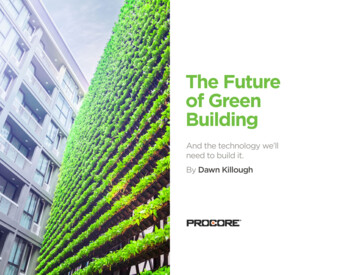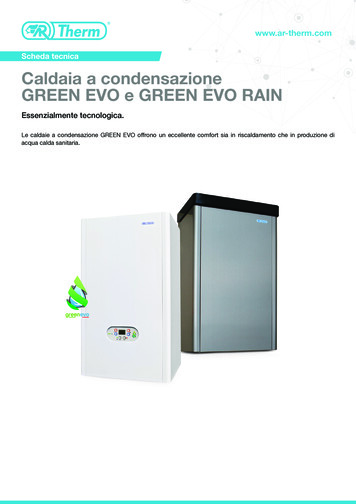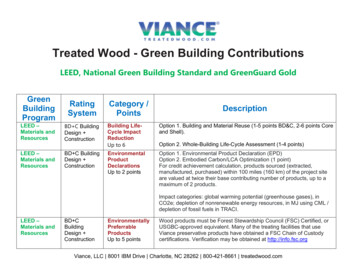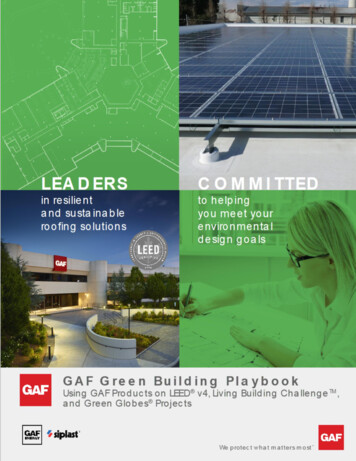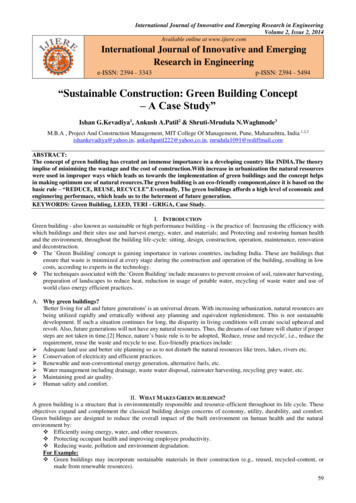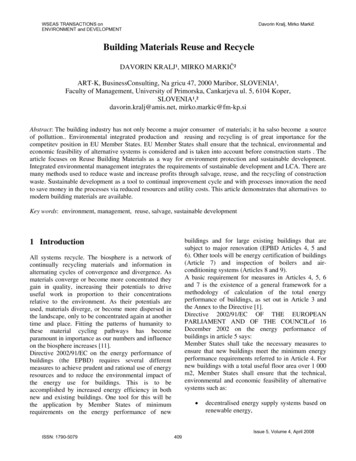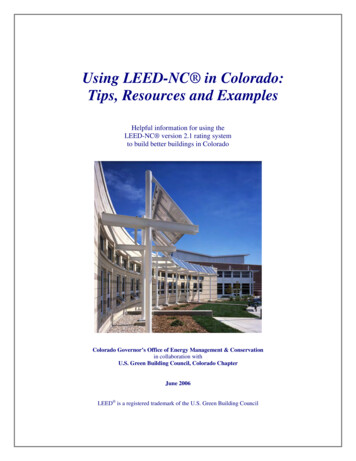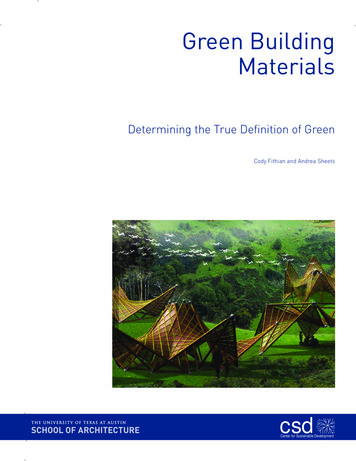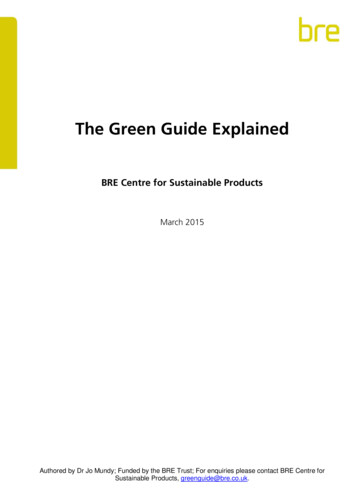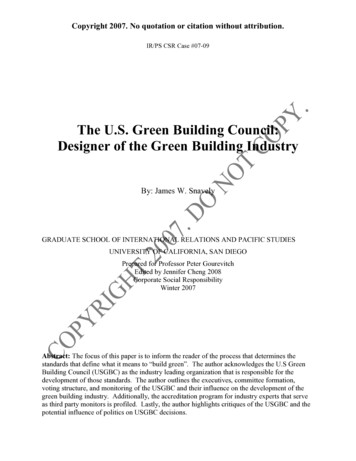
Transcription
Copyright 2007. No quotation or citation without attribution.IR/PS CSR Case #07-09The U.S. Green Building Council:Designer of the Green Building IndustryBy: James W. SnavelyGRADUATE SCHOOL OF INTERNATIONAL RELATIONS AND PACIFIC STUDIESUNIVERSITY OF CALIFORNIA, SAN DIEGOPrepared for Professor Peter GourevitchEdited by Jennifer Cheng 2008Corporate Social ResponsibilityWinter 2007Abstract: The focus of this paper is to inform the reader of the process that determines thestandards that define what it means to “build green”. The author acknowledges the U.S GreenBuilding Council (USGBC) as the industry leading organization that is responsible for thedevelopment of those standards. The author outlines the executives, committee formation,voting structure, and monitoring of the USGBC and their influence on the development of thegreen building industry. Additionally, the accreditation program for industry experts that serveas third party monitors is profiled. Lastly, the author highlights critiques of the USGBC and thepotential influence of politics on USGBC decisions.
2Copyright 2007. No quotation or citation without attribution.Table of ContentsI. Introduction.3A. The Green Building Movement.3B. Benefits.3C. Regulatory Bodies .4II. U.S. Green Building Council .5A. Overview .5B. Key Players .6C. LEED Certification.8III. CSR Problem: Why do members join? .9IV. How USGBC Benefits Members .10A. Knowledge & Resources .10B. Committees & Voting Power.10V. Analyzing Integrity of USGBC.13VI. Critics.16VII. Case Study: The Timber Industry.19IX. Further Issues .21X. Discussion Questions .22XI. Footnotes and Verifications.23
3Copyright 2007. No quotation or citation without attribution.I. IntroductionA. The Green Building MovementWhile still in its nascent stages, the Green building movement has been a steadilygrowing phenomenon. In fact, according to a U.S. Green Building Council’s (USGBC) powerpoint presentation, in the last five years alone the dollar value of green construction projects hasincreased from 3.24 billion to 10 billion (1). Green buildings are designed, built andmaintained to improve the environmental impact, economic benefits, health, and productivity ofboth the building and its inhabitants. A true green building entails water conservation, energyefficiency and renewable energy while being constructed with environmentally friendlymaterials. The incentives are great for the players in the development, construction andmanagement of green properties. Although immeasurable, companies that are associated withgreen architecture are viewed as progressive and undoubtedly benefit from this pro-environmentpublic image. The environmental benefits of green properties are numerous. Research from theUSGBC indicates these benefits range from reduced solid waste to less green house gasemissions. Green buildings have been proven to conserve natural resources and protectbiodiversity and the local ecosystem. To date, the health benefits focus primarily on occupantcomfort, natural light, noise control, improved air and water quality all feature prominently ingreen buildings. Interestingly, studies have shown an increase in worker productivity andstudent learning in green buildings and schools (2).B. BenefitsArguably the most prominent benefits in the minds of the developers and managers of greenbuildings are generally economic. For instance, the practice of streamlined permitting forbuildings with green features is becoming more common. Clearly developers who can turn
4Copyright 2007. No quotation or citation without attribution.around their projects and get them to market quicker are obviously going to benefit financially.However, the primary argument behind making money in green architecture is that there arecustomers that value the gains from going green and they are willing to pay for it. Perhaps themost easily measured economic benefit comes from reduced operating costs. More often thannot savings from energy use is the primary economic benefit from green buildings. Studies showthat green buildings use less than half the energy of conventional buildings (3). Other savingscomes from the reduction in water use. In addition to using less water, many green buildings arebeing built with self-contained water collection and treatment systems that use the collectedwater for irrigation and toilet flushing. Going green also renders financial benefits in the overallasset value and profitability of the property. Green buildings cost less to operate thanconventional counterparts and their resale and rental values reflect this accordingly. A primeexample of the potential benefits that are enticing developers to go green is the Banner BankBuilding in Boise, Idaho. This building is considered to be in the upper echelon on greenbuildings in the United States today. In terms of cost savings, the Banner building uses 65% lessenergy and 80% less water that conventional buildings. The developer, the ChristensenCorporation, asserts this reduction in operating costs equated to a 32.4% return on investment.Furthermore, they claim that increased focus on occupant comfort is directly responsible for thehigh renter occupancy (4).C. Regulatory BodiesLaws from all levels of government are the final component driving the green buildingmovement. Many federal agencies and departments such as NASA, the Department of Healthand Human Services, the EPA and others mandate that all construction projects built with federal
5Copyright 2007. No quotation or citation without attribution.funds above a certain dollar figure or square footage achieve Leadership in Energy andEnvironmental Design (LEED) certification. Currently, the U.S Army, Navy and Air Force onlyencourage LEED certification but are moving in the direction of requiring certification formilitary construction. At the state level, 22 states have incorporated LEED certification in someform or another. The most common adoption is the edict that all publicly funded buildingsabove varying square footage meet certification. However, in what is perhaps the start of a widertrend, Maryland requires that all development projects greater than 5,000 gross square feet in thestate capital meet LEED certification (5). Additionally, state and local governments areincreasingly offering tax credits and other financial incentives to developers of green buildings.For instance, from 2005-2009 the New York State Green Building Tax Credit Program is slatedto give 25,000,000 in tax credits to firms involved in the construction of green buildings (6).II. U.S. Green Building CouncilA. OverviewAs the quality and quantity of incentives has matured, so too has the number of green companieswho are looking to capitalize in the new industry. This industry wide growth prompted the needfor an industry wide standard that encompassed just what it meant to build green. The U.S.Green Building Council was the first organization to fill this need and establish the industrystandards. The USGBC is the nation’s leading coalition of companies and organizations fromacross the green building industry. USGBC consists of 100 full time staff, 75 regional chapterswith 7,500 member organizations ranging from building owners, real estate developers, facilitymanagers, architects, designers, engineers, general contractors, subcontractors, product andbuilding system manufacturers, government agencies, and nonprofits (7). The USGBC’s focuson sustainable building led to the creation and implementation of the voluntary, consensus based
6Copyright 2007. No quotation or citation without attribution.Leadership in Energy and Environmental Design (LEED) Green Building Rating System. LEEDcertification is the proof that a building has been inspected by an independent, third-party and isan environmentally responsible, profitable, and a healthy place to live and work.B. Key PlayersA closer look at the leading people of USGBC and its broader member base is required in orderto support their position. The U.S. Green Building Council’s board of directors is made up to 27directors with 6 additional directors on the executive committee. The current chairman of theboard is Sandy Wiggins. Mr. Wiggins has worked in real estate development and theconstruction industry for over 30 years and has been involved with projects worth over 750million (8). He is the founder of Consilience, LLC, a consulting, development and projectmanagement firm that focuses on green building. Mr. Wiggin founded and actively chairs thePhiladelphia chapter of the USGBC and is a director of the Energy Coordinating Agency (ECA).The ECA is a private, non-profit that focuses on access to safe, affordable and reliable sources ofenergy and water for low income people. Mr. Wiggin also serves as a director on thePennsylvania Resource Council, a national leader in waste reduction and recycling.Additionally, Mr. Wiggin is an active director for the Delaware Valley Smart Growth Alliance,an organization that promotes smart growth projects by advising proposed projects prior todevelopment approval. A second member of USGBC’s executive committee is S. RichardFedrizzi, the President, CEO & Founding Chairman of the U.S. Green Building Council. Mr.Fedrizzi’s green career started when he founded Green-Think Inc. an environmentally focusedmarketing and consulting firm for the residential and built environments. With Mr. Fedrizzi onthe council, the USGBC has initiated three new rating systems and partnered with the ClintonClimate Initiative to implement green building programs in 40 of the world’s largest cities. Mr.
7Copyright 2007. No quotation or citation without attribution.Fedrizzi is considered the driving force behind USGBC’s commitments to green schools and thecouncil’s movement to combat global climate change (8).The current chair elect on USGBC’s executive committee is Rebecca L. Flora. Ms. Florais currently the executive director of the Green Building Alliance (GBA), a non-profitorganization that focuses on the green education and project facilitation. Ms. Flora was also thehead accreditor for Pittsburgh's 350 million convention center project, the first greenconvention center in the world. Additionally, Ms. Flora is a graduate school adjunct professor insustainable community development at Carnegie Mellon University's Heinz School of PublicPolicy and Management. The current treasurer of USGBC’s executive committee is Mr. VanBelleghem, a CPA with over 18 years of experience in real estate development. Mr. VanBellegham is also a managing partner in Windmill Developments, a Green Buildingdevelopment company and the president and founder of BuildGreen Development Inc, a greenproject consulting firm. The last member of USGBC’s executive committee is Gail Vittori, thecurrent secretary. Ms. Vittori has worked at Maximum Potential Building Systems, a non-profitdesign firm that focuses on sustainable planning, design and demonstration for 25 years. Ms.Vittori is also a founding member of the Healthy Building Network, a national network of greenbuilding professionals, environmental and health activists committed to making improvements inpublic health (8).The remaining 27 directors come from an array of reputable organizations. Naturally, themost represented companies are a diverse grouping of green building organizations. GreenTimeLLC, Ecotrust, Alliance for a Sustainable Built Environment, Sustainable Products Corporationand Yarmuth Radoff Green Sustainability Consultants are a few from this category. However,the other companies that are represented by the board members are extremely diverse. For
8Copyright 2007. No quotation or citation without attribution.instance, Tony Gale, Starbucks Coffee Company’s Corporate Architect sits on the board. Mr.Gale oversees the design and construction standards on all Starbuck's coffee houses. Also,Timothy S. Carey, the President and Chief Executive Officer of the New York Power Authorityis also a board member. Additionally, Dan Burgoyne, the Sustainability Manager for the State ofCalifornia's Department of General Services is a director. Mr. Burgoyne’s implementssustainable building, energy and resource efficiency at the California state level. Lastly, LisaShpritz, a Vice President of Corporate Workplace for Bank of America in Charlotte, NorthCarolina is also on the board. Mrs. Shpritz is responsible for environmental programs andimplementation for over 90 million square feet in Bank of Americas across the country. Theupper echelon of the USGBC appears to be composed of accomplished people from highlyreputable companies. While only one component to establishing legitimacy, USGBC’s staff is apositive selling point for their credibility.C. LEED CertificationIn particular, LEED certification focuses on six major areas of efficiency and design; siteplanning, water management, energy management, material use, indoor environmental airquality, and the innovation and design process (9). Additionally, the LEED rating system takesthese six areas and creates individual specifications according to building type. For instance,New Construction, Existing Buildings, Commercial Interiors, Core and Shell Development,Homes, Schools, and Neighborhood Development all have their own rating system. The actualcertification process entails awarding points for meeting certain requirements and then tallyingthe points to determine the LEED rating. Currently, the USGBC has established four levels ofLEED, platinum, gold, silver and certified. For a project to be considered for LEED certificationit must meet all LEED specified prerequisites and thereby achieve the Certified level of LEED
9Copyright 2007. No quotation or citation without attribution.project certification. More requirements must be met thereby earning more points to move upthe scale to the more stringent levels. At the end of the certifying process, LEED will bestow thebuilding with an award letter, certificate and metal LEED plaque indicating the certificationlevel.This rating system is actively developed via a consensus voting system that begins whenvolunteers on the LEED Steering Committee approve a recommendation to the USGBC board ofdirectors. If the board decides to move forward with the release of a product or item they believemeets LEED standards, the USGBC’s due paying members are then given the opportunity tocomment and vote on the product or item. Approval mandates a two-thirds vote by at least 10%of the members for a standard to be approved. At first glance, this process seems odd, themembers of the USGBC are the firms and organizations that serve to benefit from attainingLEED certification. However, these are the same members that set the rules of what exactlyLEED certified means. Are these member organizations setting the bar low so they can achievecertification at low costs or are they setting the bar high in order to distinguish themselves fromconventional firms? Coupled with that fact that in the past five years voting members in theUSGBC has grown by over 500%, understanding the benefits of membership might help todecipher the USGBC’s role.III. CSR Problem: Why do members join?As outlined above, the health, environmental and economic gains from going greencontinue to have a growing acceptance. However, the question arises to why firms ororganizations interested in these benefits are compelled to accept the USGBC’s standards inorder to recognize the gains. Why does the USGBC have over 7,500 member organizations thatpay anywhere from 300- 12,500 annually? While this quantity of reputable business further
10Copyright 2007. No quotation or citation without attribution.helps to legitimize the USGBC as the nation’s leading green architecture coalition, a furtherevaluation determining why exactly these members want to be a part of the organization iswarranted. It seems necessary to determine if their inclusion is entirely self-interested at theexpense of environmentally best practices.IV. How USGBC Benefits MembersA. Knowledge & ResourcesSimply put, the USGBC promotes itself as the industry leading resource for greenbuilding. They claim to have more knowledge and access to practical experience than any otherorganization. Their information and technical experience is designed to be used as a blueprintfor firms that want to go green. The first benefit that members gain is discounts on USGBC andLEED programs and publications. These discounts range anywhere from 50- 5,000 on expos,seminars, manuals and project registration and certification fees (10). A second benefit is accessto USGBC resources that are entirely in-house. Research reports and a database of past LEEDcertified reports are available for members to use and implement on their own projects.Additionally, the networking ability that comes with membership and access to the USGBC’sdirectory is viewed as a premium on membership. With membership growing at over 1,000 newmembers a year it appears that many support the notion that the USGBC is the primary greenbuilding association.B. Committees & Voting PowerAdditionally, their LEED certification is the national benchmark that distinguishes greenbuildings from conventional ones. In my opinion, the most enticing member benefit is the abilityto serve on committees and the ability to vote on what exactly it means to be LEED certified.The USGBC claims that its committees are the core component in their ability to provide
11Copyright 2007. No quotation or citation without attribution.industry guidelines for green buildings. While consensus voting by all of the members is thecommon practice, the committees are labeled the primary shapers of future LEED and greenbuilding practices. Any member of USGBC can serve on an array of committees that arespecifically designed to include a diverse selection of member categories. As seats becomeavailable, existing committee members nominate and elect new members to fill certain positionswhile the executive committee reserves the right to appoint committee Chairs and Vice Chairs.The USGBC’s guidelines state that the Chair or Vice Chair of the LEED Steering Committee,the most influential committee, must be a Council Board member. Interestingly, at the time ofwriting, there were no openings on any USGBC’s committees. I would argue this fact to be aclear indication that volunteering on a committee and having a voice in decision making isvalued. Furthermore, it seems hard to believe that USGBC members would volunteer their timeunless there was some kind of return on their effort. I would further argue that their role as anunbiased industry standard architect would be supported if the USGBC’s committees are indeedformed from a broad spectrum of individuals with a variety of self-interests and their entiremember organization is given voting power. However, while not stating this is not the case,determining this in every decision made by every committee that involves a LEED product orrating is a difficult task.A closer look at how LEED committees are organized renders information into theinfluence that committee members are given. According to LEED’s 2006 Committee CharterReport (pgs. 1-26), the most influential LEED committees are the Steering Committee and theManagement Sub-Committee. In conjunction with the USGBC board of directors, these twocommittees are charged with the establishment and enforcement of the LEED product line andrating system. They are further charged with delegation responsibilities and overseeing all
12Copyright 2007. No quotation or citation without attribution.LEED committee activities. In short, all major decisions that involve LEED products and ratingsystem go through these two committees at some point. Additional committees that holdinfluence are the Horizontal and Vertical Market Committees. These two groups are chargedwith the criteria and technical development of individual products and products that span entirebuilding sectors. The Technical Advisory Group is another committee that plays an importantrole in the LEED system. This group is responsible for LEED products meeting the technicalrequirements of the LEED rating system. Other committees that are given a voice are individualchapter steering committees. These committees work with state and local governments to ensureLEED products meet local laws or the local laws are negotiated to encompass LEED products.At first glance it is arguable that a conflict of interest exists amongst the members of theUSGBC’s committees and their decision making power. LEED committees have the power todirect which products are voted on to become LEED certified and therefore have the ability tosteer decisions into personal profit making outcomes. To protect against this event, the LEEDCommittee Policy Manual has a “Conflict of Interest Policy” requiring that voting members whohave a conflict of interest must disclose this to the USGBC (11). The corresponding committeeshall then decide whether the individual will be allowed to vote on the subject at hand.However, at the time of writing, the inquiries the author made to the USGBC as to the frequencyof committee members not being allowed to vote rendered no information to answer thisquestion. A further check on an individual committee member pursuing a personal interestpolicy is the practice of assuring that a minimum of five member categories are represented onall LEED product committees. This balance is designed to assure a broad set of expertise andinterests in the decision making processes.
13Copyright 2007. No quotation or citation without attribution.Perhaps the strongest step the USGBC has taken to assure legitimacy is allowing theirentire member base to voice their opinion and vote on the development of LEED products andstandards. Detailed product policies are available for all members to review and can be readilyattained at the organization’s website. A potential LEED product begins with identifying amarket niche and determining the scalability of the product. If the Steering committee believesthe product viable, they approve the formation of a Core Product Committee to commenceproduct development. This committee is then comprised of both appointed and elected membersthat meet a specified criterion outlined by the Executive Committee. If the product provestechnically sound by the Technical Advisory Group the committee is given the green light topilot the product and report the findings to the USBGC board and Steering Committee. At thispoint, USGBC’s members are allowed to review the product and research and give feedback.The Steering Committee then refines the product based on the member feedback and thenproceeds to ballot the product. If approved by two-thirds of those voting, the product isimplemented into the LEED rating system and the product is marketed to interested groups. TheLEED rating system is developed in largely the same manner. This development andimplementation process is an open and evolving process that continually incorporates newtechnologies and trends. The USGBC argues this consensus based voting system coupled withthe open balloting of new products ensures the integrity of LEED brands.V. Analyzing Integrity of USGBCIn fact, the USGBC’s further argues that its interest in maintaining brand integrity isperhaps the primary selling point as to why they should be accepted as the organization thatoutlines industry standards. The USGBC has the following: the professional member base that is
14Copyright 2007. No quotation or citation without attribution.willing to pay them thousands of dollars annually; the consensus voting system that is viewed asfair and democratic; and a firm lock on the role of draftsman for the future of green building, anindustry whose dollar value has grown drastically in the last five years. In short, if the USGBCare rational thinkers, they will recognize that times are good and any blight on the LEED brand iscounterproductive to the larger picture and future gains. Of course, determining the USGBC’sultimate agenda is extremely difficult. However, the USGBC has implemented additionalcontrols that they claim strengthens their LEED brand’s high level of quality. The first step theUSGBC took was to keep all licensing of their LEED in-house and not by a third party. Theybelieve this certifies a high standard that cannot be compromised by decision makers other thanthemselves. They also position themselves as the experts in the field by creating and offeringcredible sources of green building education sources. They argue that if their member base isgiven access to information about the leading technology, most recent case studies, marketresearch reports, and workshops their position as the leading source for green information isfurther cemented. Lastly, the USGBC places emphasis on maintaining high levels ofconsistency, stringency and quality across all their LEED brands in order to deliver a highquality product.The USGBC also feels their LEED professional accreditation program supports theirposition as the industry leader for all things green. A LEED Professional Accreditation is proofthat an individual comprehends green building practices and principles, can steer a projecttowards meeting the LEED certifications and is an expert in the LEED rating system. In fact,many green projects mandate that a LEED Accredited Professional (AP) be involved andprojects actually receive a LEED point for staffing a LEED AP. The LEED AP assists thedeveloper to make sure the project will eventually meet LEED requirements and helps process
15Copyright 2007. No quotation or citation without attribution.the legal documents that hold the ultimate responsibility for the determination of the LEEDcertification. The LEED AP is essentially the outsourced monitor for the USGBC who does notactually inspect the building themselves. Like all systems, the USGBC’s can fall victim to fraudespecially lacking an individual 3rd party inspection of the buildings. However, the author arguesthat there are a few incentives as to why the USGBC’s system might prove sound. Besidesreputation, the primary incentives for the developers and monitors to do honest work are thefinancial benefits from constructing a true green building. A falsely labeled green building willnot provide the desired cost savings the developer seeks and hiding this from potential buyers orrenters would be difficult. Furthermore, the differentiating qualities of a green building areeither present or they are not. The building either uses less water, allows for more natural light,has better air quality or it doesn’t. Falsifying documents on these subjects by either thedeveloper or the LEED AP seems difficult. None the less, LEED AP appears to play a highlyinfluential position in the certification process.There are currently over 35,000 LEED accredited professional is a testament to the scaleof the green building industry. Examining the process of how a person becomes LEEDaccredited is necessary to help determine their credibility and motivation in the overall process.First off, there are no barriers to entry for taking the certification test. However, the USGBCdoes encourage the individual to have experience in the field and prior knowledge of LEEDbefore signing up for the 250- 350 test. Regarding the content of the tests, the USGBC writes,The development of a valid exam begins with a clear and concisedefinition of the knowledge, skills and abilities needed in order tosuccessfully serve as a LEED Accredited Professional. Psychometricianswork with experts in the green building industry to identify criticalcomponents of the roles and responsibilities of an individual supportingthe LEED certification process (12).
16Copyright 2007. No quotation or citation without attribution.Additionally, the USGBC claim there tests to reflect current standards and business practices.Interestingly, LEED identifies six building types but only offers three corresponding exams andclearly states that passing any one test will allow the individual to serve as LEED AP for all theother
Environmental Design (LEED) certification. Currently, the U.S Army, Navy and Air Force only encourage LEED certification but are moving in the direction of requiring certification for military construction. At the state level, 22 states have incorporated LEED certification in some form or another.



